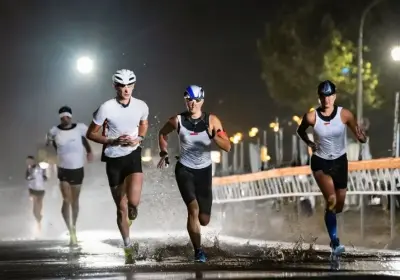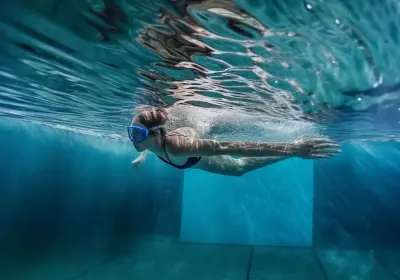The heart rate in triathlon

- 1. Understanding Heart Rate in Triathlon Training
- 2. Importance of Monitoring Heart Rate in Triathlons
- 3. Optimal Heart Rate Zones for Triathlon Training
- 4. Factors Affecting Heart Rate Variation in Triathlons
- 5. Strategies to Manage and Improve Heart Rate for Triathlons
1. Understanding Heart Rate in Triathlon Training
Clicking into gear, your heart starts to rev, maintaining a steady rhythm as you embark on your triathlon training. But what part does your ticker actually play in your performance? The significance lies in understanding your resting and maximum heart rates and harnessing this knowledge to optimize your endurance training. The resting heart rate- measured when you're calm and relaxed- gives a window into your basic fitness level, while the maximum heart rate- the top speed your heart can safely reach- is the ultimate test of your athletic exertion. Accurately gauging these values, then, paves the way for balancing your exertion levels and advancing your physical stamina, thus pushing your triathlon performance to unexplored heights. Remember, your heart rate isn't just a number; it's the BPM of your athletic symphony.
- Defining Resting and Maximum Heart Rate
The concept of Resting and Maximum Heart Rate constitutes a crucial understanding in the triathlon training sphere. So what exactly does it mean? Your Resting Heart Rate (RHR) is the number of times your heart beats per minute (bpm) when you're completely at rest. An average RHR could be anywhere between 60-100 bpm for most adults, although well-trained athletes often record RHRs as low as 40 bpm. It's important to note that a lower RHR typically indicates a higher level of cardiovascular fitness. On the other side of the spectrum is your Maximum Heart Rate (MHR), an essential value in the determination of your training zones. This denotes the highest number of beats your heart can handle during maxed-out physical exertion. A simplistic way to roughly estimate your MHR is the formula 220 minus your age. However, this only provides an approximation, and specific tests are recommended for an accurate figure. The MHR is pivotal as it establishes the intensity at which you can and should train, fostering efficiency and boosting endurance. Understanding and differentiating between the RHR and MHR thus becomes the key to effective, personalized triathlon training, setting the foundation for benchmarks, progress tracking, and performance optimization. Remember, every heartbeat counts in the endurance world, so make yours productive by incorporating resting and maximum heart training into your routine. Now, how well tuned into your heart rates are you?
- The Role of Heart Rate in Endurance Sports
The role of heart rate in endurance sports cannot be overemphasized. Being conversant with your heart rate while engaged in triathlon training plays a cardinal part in ensuring you achieve optimal results. Heart rate is the effective measure of your body's effort level. The higher your heart rate during training, the harder your body works. More so, it's imperative to note that the heart responds accurately to variations in exercise intensity during a triathlon event. It's a simple yet profound gauge that allows athletes to engage in effective, individualized intensity exercises. Training by heart rate takes into account your level of fitness, thus preventing overtraining while ensuring you attain maximum benefits from your efforts. An athlete's heart rate at rest, during exercise, and recovery time offer valuable insights into their cardiovascular fitness. Whether you're a newbie triathlete or a seasoned professional, comprehending your heart rate allows you to manage your endurance, gauge your efforts accurately, and excel in your races. Hence, understanding your heart rate is a vital component of successful triathlon training. It irradiates a clearer path towards achieving long-term success in endurance sports. Bypassing the importance of heart rate in triathlon training could inadvertently limit your potential.
2. Importance of Monitoring Heart Rate in Triathlons
Monitoring your heart rate during triathlon training is critical for several reasons. For starters, it allows you to predict your performance pace, enabling you to train more effectively and reach your potential. Moreover, by tracking your heart rate, you can gauge your fitness progress, understanding how your body is responding to the strenuous exercise regime. This vital information can provide insight into your overall health and wellness, guiding you towards any necessary adjustments in your training. However, to fully harness the benefits, it's essential to understand the specifics of what heart rates are considered optimal during your workout. This will ensure a triathlon training experience that's not only effective but also safe and healthy. Always remember, in triathlon training, your heart isn't just a beat - it's the drum that signals your body's symphony.
- Predicting Performance Rate
Keeping a keen eye on your heart rate during a triathlon is often the key to predicting your performance rate. This data provides critical insight into your body's response to the pressures of endurance sports. Navigating the terrains of swimming, cycling, and running requires a deep understanding of your physical capacity - and your heart rate is perhaps the most accurate indicator of this. By analyzing variations in your heart rate, you can get cues about when to push harder and when to pull back. This ensures that you maintain an optimal balance between high intensity and recovery periods. After all, a successful triathlon performance is not just about speed, but also about longevity and endurance. Furthermore, consistent heart rate monitoring helps to avoid over-training, therefore reducing the risk of injuries and burnouts. So, if you've set your sights on improving your triathlon performance, invest in a reliable heart rate monitor and learn to interpret the data it presents. It's like having a personal coach guiding you, pushing you in the right direction and ensuring you reach your full potential while safeguarding your health. The key is to understand your heart – both metaphorically and quite literally! Do you pay attention to your heart rate during your triathlon training?
- Tracking Fitness Progress
One fundamental detail that cannot be overlooked in your triathlon training journey is the tracking of fitness progress. Imagine embarking on a demanding routine for months only to discover that very little progress has been made. Sounds disheartening, doesn't it? To avert such instances, effective heart rate monitoring is paramount. Your heart rate gives a reliable insight into how your body responds to various intensities of training. Regular monitoring not only helps in hitting your fitness goals but also ensures that you stay in tune with your physical needs without pushing excessively. We can consider it a real-time feedback mechanism about our body's capabilities, limitations, and performance level. However, do remember, tracking heart rate data is not about obsessing over every beat. It's more about recognizing patterns, changes, and potential red flags. So, when you note consistent fluctuations in your heart rate during specific workout stages, it's an indication of your fitness growth. Additionally, improvements in heart rate recovery are a strong, indicative factor of increased cardiovascular fitness. It embodies how quickly your heart rate can return to its resting state after intense activity. This valuable data can empower you to chart out a high-performance, customized training plan oriented towards consistent improvement and achieving your triathlon goals. It's not just about training harder, but training smarter!
3. Optimal Heart Rate Zones for Triathlon Training
Training for a triathlon entails the careful understanding and regulation of your heart rate in various zones. Each zone has a specific impact on your performance and will ensure you can sustain a high level of effort throughout your race. Zone-based training not only improves your fitness but also increases your body's capacity to handle strenuous exercises. When you understand each zone, from the easy-going Zone 1 to the vigorous Zone 5, you unlock your body's full potential. Each zone targets different types of fitness and enables efficient energy utilization, making them all crucial parts of your training regime. So, if you want to power through your next triathlon, learn to attentively listen to your heart. Keeping a pulse on your performance has never been more literal, or crucial.
- Zone-Based Training: Distinguishing Each Zone
Zone-based training is critical in triathlon preparation as it helps you understand and control your heart rate better, ensuring optimal sports performance. Each zone in this form of training represents a specific range of your maximum heart rate and has a unique impact on your workout. The Zone 1 is the lowest intensity level, where you're training at 50-60% of your maximum heart rate; it enhances your basic endurance and helps in recovery. While in Zone 2 (about 60-70% of maximum HR), you experience improved aerobic fitness that assists in fat burning. Zone 3 (70-80%) is the so-called 'aerobic zone', where both your aerobic and anaerobic systems are engaged, improving overall cardiovascular fitness. Zone 4 (80-90%) — often referred to as the 'threshold zone' — increases your anaerobic capacity, improving lactic acid tolerance. Lastly, the Zone 5 (90-100%) is the high-intensity area where the maximum improvement in your speed and power occurs. By distinguishing these zones and training in each one, you're armed with the capability to better tailor your training, optimize your efforts, and ultimately, boost your triathlon performance. It's akin to moving the gears in a car: each one has its specific purpose, and the best drivers know exactly when to shift gears. Consequently, using a zone-based approach in triathlon training ensures you 'shift correctly', amplifying your performance while minimizing the risk of injury.
- Importance of Training in Every Zone
Training in every zone is a key component in triathlon training, but why is it so crucial? It all boils down to the concept of training diversity. Let's think of your heart as an engine that operates at various intensities. For instance, in Zone 1, your heart is in a lighter state, allowing you to exercise for longer periods. It helps to build endurance, recover from intense workouts, and prepare your body for tougher zones. In Zone 2, you push your heart to work harder. Still, it's a moderate-intensity zone where you can talk while exercising. It aids in improving aerobic capacity- the ability of your heart and lungs to get oxygen to your muscles. Zone 3, often avoided by athletes, balances on the tricky line of moderate-strenuous training. It serves as a transition to high-intensity zones, promoting efficiency and pace. Zone 4 stretches your anaerobic threshold, the point at which lactic acid starts to accumulate in the muscles. Training in this zone enhances your speed and power, allowing you to sustain higher intensities for longer. Lastly, Zone 5 involves all-out efforts that you can only maintain for short periods. It enhances your maximum power and speed. Training in every zone brings versatility to your sessions, making you a well-rounded triathlete ready to face every challenge that a triathlon race throws at you.
4. Factors Affecting Heart Rate Variation in Triathlons
When it comes to triathlons, a variety of factors can significantly influence heart rate variations. The most pronounced among these is the inherent type of sport engaged at different stages of the competition. For instance, your heart rate tends to spike during the swimming stage due to the body's response to cold water and the challenge of simultaneously coordinating breathing and strokes. During cycling and running stages, heart rates can be influenced by variations in terrain - uphill tasks demand more cardiovascular effort, thus escalating heart rates. Environmental aspects, too, play a significant role. Factors like temperature, altitude, and humidity can affect the cardiovascular system and cause noticeable heart rate fluctuations. Understanding these factors can help triathletes manage their training and performance.
- The Impact of Different Sports on Heart Rate
The impact of different sports on heart rate is a critical phenomenon to consider when triangulating your performance in triathlons. Each sport within the triathlon discipline, namely swimming, cycling, and running, affects heart rate differently due to the specific demands placed on the body. For instance, swimming, while it's generally a low-impact sport conducive to cardiovascular health, tends to elicit a slightly lower heart rate than other disciplines. This is attributed primarily to the body's prone position and the pressure on the chest while underwater – both laboring respiration and consequently reducing heart rate. On the other hand, cycling usually generates a moderate heart rate response due to the body's upright position and the recruitment of large muscle groups in the lower body. However, it can spike considerably during uphill struggles and high-intensity sprints. Lastly, the heart rate is often observed to be the highest during running, due to the higher muscle stress, vertical impact forces, and the instability of the upright stance that requires constant balancing, all of which contributes to an elevated heart rate. Understanding these variations is crucial as it aids in creating a structured, multi-disciplinary training plan – with heart rate targets specific to each activity – ensuring maximum effectiveness and improved overall triathlon performance.
- Role of Environmental Factors
In the world of triathlons, the role of environmental factors on heart rate is monumental and cannot be undermined. Your heart rate does not exist in a vacuum – it reacts and adapts to the environment around it, almost like a mirror reflecting your surrounding conditions. Weather patterns and geographical elements, for example, play a considerable role in how your heart performs during a triathlon. Colder atmospheres tend to increase heart rates as the body strives to maintain its normal temperature. In contrast, hot weather, especially when coupled with high humidity, can cause your heart rate to skyrocket due to the increased need for cooling down your internals. Altitude is yet another significant factor, with higher elevations causing increased heart rates as there’s less oxygen in the air. These environmental factors can sometimes mean the difference between a record-breaking performance and a disappointing outcome. Hence, smart triathletes not only train their bodies physically but also acclimate to the environmental conditions they will be performing in. But remember, your heart rate is merely a tool in your training arsenal. It's crucial to amalgamate this with your subjective feelings of exertion for a complete and nuanced understanding of your training efficacy. After all, success in triathlons, like in life, is a balance of many diverse elements!
5. Strategies to Manage and Improve Heart Rate for Triathlons
Strategies to manage and optimize heart rate play a crucial role in triathlon training. Recognizing your body's response to varying degrees of exertion can provide key insights into your fitness level and help streamline your training routine. An integral part of this strategy is understanding the significance of heart rate recovery. This metric reveals how quickly your heart rate drops after intense exercise, serving as an important indicator of cardio health and overall endurance. Moreover, enhancing your heart training approach with heart rate monitors can prove advantageous. These gadgets offer real-time data of your heart's performance, enabling you to adjust your routine for maximal benefit. Navigating through the array of sports technologies might seem perplexing, but finding a device that fits your style and needs pays off in elevating your triathlon performance. This isn't just an upgrade to your gear, it's an upgrade to your training. Can you imagine the impact this could have on your next triathlon performance?
- Heart Rate Recovery and Its Significance
In the realm of triathlon training, understanding Heart Rate Recovery (HRR) and its significance is a game-changer. After reaching peak intensity during exercise, the rate at which your heart returns to its resting pace is what we refer to as HRR. But why does it matter? Here's the thing: HRR is a potent indicator of your cardiovascular fitness level. For instance, if your heart rate drops significantly within a minute after halting intense exercise, this implies that you have a solid fitness base. On the contrary, a slow recovery could suggest that you're pushing it a tad bit too hard, or worse, it may indicate possible heart-related issues. Yet, it's not all about the alarming signs. Harnessing HRR can also help you fine-tune your training regimen. A second set of endurance work? An increased pace on the running track? Your HRR is a reliable guide in these scenarios. But remember, to capitalize on HRR, consistency is king. Thus, tracking your heart rate over time is crucial. This knowledge, teamed with the use of reliable heart rate monitors, can create a huge difference in your triathlon performance. But that, dear reader, is a discussion for another time. Stay tuned!
- Using Heart Rate Monitors for Optimal Performance
When it comes to maximizing your performance in triathlons, utilizing heart rate monitors can play an instrumental role. The journey to triathlon success is best navigated with a reliable ‘map’ - in this case, a heart rate monitor which interprets your body’s language, translating tiny heartbeats into valuable data. This nifty gadget is not just to count how fast your heart is racing, but a compass guiding you to train at the right intensity based on your heart rate zones. So, how does this translate into winning races? Training within your optimal heart rate zones ensures you don't under or overtrain, thereby boosting your endurance and pace significantly. Understanding your heart rate data equips you with essential information about your physical state. It can reveal if you're pushing too hard during training, or not enough, and help you adjust accordingly. Long story short, mastering the usage of heart rate monitors allows you to know your body like the back of your hand. But, remember, these gadgets merely offer insights – your will power does the heavy lifting. So, whether you're eyeing the finish line or simply trying to outdo yourself, keep track of your heart both literally and metaphorically. After all, at the heart of triathlon success is a...well, a heart. Don't you agree?
In conclusion, an understanding of heart rate and its significant role in triathlon training is crucial. Monitoring heart rates can offer valuable insights into predicting performance, tracking progress, and distinguishing optimal training zones. Factors such as individual sports and environmental elements can affect heart rate variations. Therefore, employing strategies, such as recognizing the significance of heart rate recovery and utilizing heart rate monitors, can meaningfully enhance a triathlete's performance and training efficiency.
- What is meant by Resting and Maximum Heart Rate?
- Resting Heart Rate is the number of times your heart beats per minute when you are at complete rest, whereas Maximum Heart Rate is the highest number of times your heart can beat in a minute during maximum physical exertion.
- How does the heart rate affect performance in a triathlon?
- Heart rate plays a significant role in sustaining performance during a triathlon. By monitoring and managing it, athletes can pace themselves effectively and ensure they do not exhaust their energy resources prematurely.
- Can you explain the concept of Zone-based training in Triathlon?
- Zone-based training involves dividing your heart rate into different zones (usually five), each representing a level of effort and intensity. It develops various aspects of fitness, including endurance, aerobic capacity, and anaerobic power.
- How can different sports and environmental factors impact the heart rate during a Triathlon?
- Different sports require varying effort levels, affecting the heart rate. For instance, swimming might raise the heart rate more quickly than cycling. Environmental factors like temperature, humidity, and altitude can also significantly impact the heart rate.
- Why is Heart Rate recovery significant in Triathlons and how can Heart Rate monitors help in achieving optimal performance?
- Heart Rate Recovery, the speed at which your heart rate declines after exercise, is an indicator of fitness and recovery capacity. Heart rate monitors can help accurately track these changes, providing insights to optimize training and race performance.


















































Leave a comment